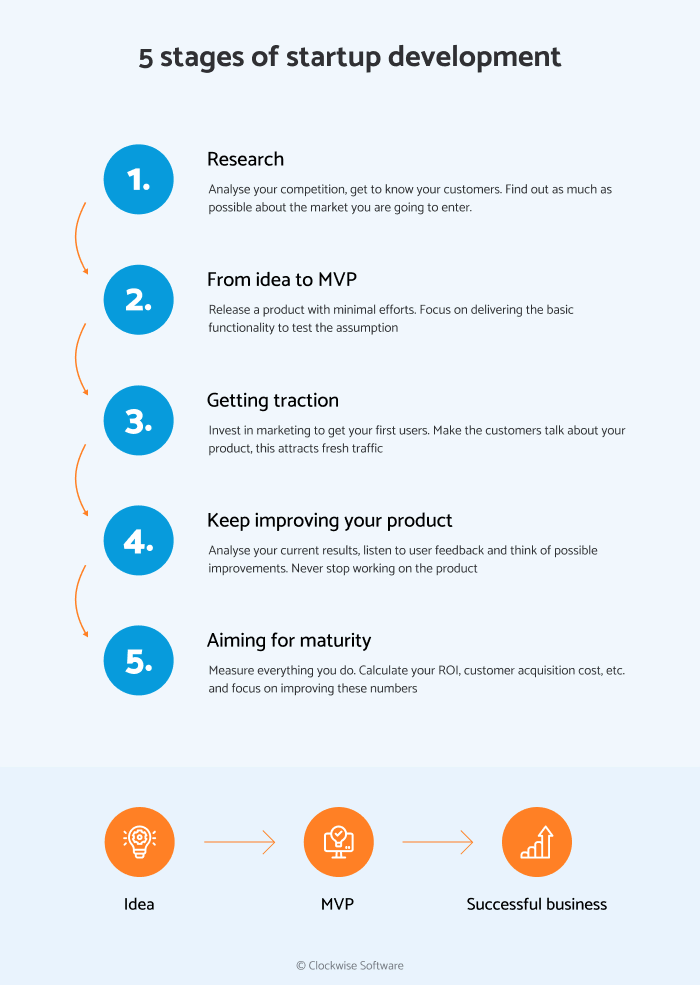What we do
Services
Experts in
Success stories don’t equal miracle stories. Your feed is probably full of fairy tales about 18-year-olds who successfully go through every stage of a startup and make millions on their ideas. In reality, this process has its dark sides.
In a world where seemingly everything has already been invented, a unique idea is worthless and useless if you don’t hone it. So, whether your business idea is a forerunner in a target niche or a smart alternative to a successful CRM, you have to cultivate it.
There are several different approaches to startup development you can choose from. A rather formal approach is to define startup development by its lifecycle stages: early venture, series A, and growth. Each of these covers a range of activities.
The goals of these are:
You can either rely on these three or define the stages of creating a startup based on your own strategy.
In this article, we identify five startup phases that you’ll most likely have to go through. This is a straightforward way to get from a promising idea to a well-established company. However, to make this transition happen, you have to take action. Ready?
A successful startup is a journey from idea to growth and you should know the path you’ll be walking. Still, it’s the execution that matters most. To nail every stage of a startup business, there are a couple of things to consider during each of these stages:
Actively search scaling capabilities. After you have a solid MVP, scaling begins, but that doesn’t mean you should ignore it before then. When planning features and trying to find a product-market fit, keep in mind that if you plan to scale up in the future, you’ll need investments. Catering to that at each stage of development is half of success.
Have a business plan. This will be developed and perfected as your startup idea evolves. Similar to scaling, approach your business plan in the early stages so that you can present your idea to investors, potential partners, and anyone interested whenever they ask about it.
Document everything that can be documented. From the most basic overview of your business idea to recruiting and scaling, try to document everything related to your startup in written form. This will saves time later while improving and growing your business in the future.
Now that you know the rules of the game, let’s go through the stages of a startup.
As we’ve mentioned before, there’s always space for new phenomena in the startup world. The founders of Airbnb, two designers, and an engineer have said that they lacked a common perspective at the dawn of the company – largely because they were focused on design and engineering instead of on developing a business. And yes, these are two completely different things.
When we talk about startup phenomena, we mean businesses like Airbnb. Due to the unique concept of “renting a living space where you feel at home,” Airbnb basically created a new niche from scratch. So, it should be treated as an exception, rather than a rule.
We recommend your idea startup stage be focused around strategy, risk management, and a clear vision shared by the whole team. Whether you’re a newbie or an experienced entrepreneur, don’t let your passion rush you in with no plan. Here are two key things to consider during your research:
According to Entrepreneur, the so-called Keller approach suggest moving in four directions while researching your business idea: company, customer, competitor, and collaborators.
A plan should describe exactly what has to be achieved before you start building an MVP. This could be a list of experts you want to interview, a clear image of your target customers, competition research, or a combination of multiple objectives.
Study what your competitors have to offer and focus on what they don’t. No matter how successful a business is, there are always gaps – something that could potentially be of use for your target audience.
Let’s say if you create an app for iOS or Mac and your main competitors are only available on the Apple Store. This is an opportunity to your app out there by getting featured on additional platforms. For example, for Mac apps, there’s a subscription service called Setapp, and with iOS apps you can consider Fliptopia. Get your product featured on the platforms which your competitors don't use. Targeting the gaps is the fastest way to get into the leadership zone.

As soon as you have a hypothesis about your future product, focus on validating it. A Minimum Viable Product (MVP) is a must-have set of features that allows you to test the product with your target audience without any sophisticated engineering. Minimum effort – maximum feedback. With an MVP, you can see the practical impact of your product in the real world and then further perfect it.
Airbnb started as a simple listing website that targeted the attendees of the IDSA conference that took place in San Francisco in 2007. The Airbnb founders noticed that all the hotels were overbooked for the conference dates and decided to create a quick solution. That’s how the world’s major hospitality service evolved – by solving a specific problem for a relatively small crowd of conference attendees.
The first Airbnb website was cheap and it is even hard to compare to what the service offers now. But, as the experience shows, your MVP shouldn’t be a world-saver. One practical issue you have a solution for will be enough.
Here are the basic steps for creating your MVP:
There’s no agreement on how much time you should spend on building an MVP. For some companies, 6 months won’t be enough, while others can have theirs ready in a week. Plan based on your specific features and the size of your team. Apart from coding, plan some time for measuring results, and remember that feedback is key for moving forward.
Many small startups have a tight budget on the initial stages of development. Nevertheless, starting a company without an MVP is a death sentence. If you can’t afford to hire an in-house team, you can hire dedicated development team to create the first prototype of your product. Once you have validated your idea, you can either continue working with outsource providers or recruit a team.
You also have the option to hire a CTO responsible for MVP creation. This usually works with well-funded companies and products that require dedicated tech expertise.
Don’t just wait for people to give you the right ideas. Instead, ask questions that you need the answers to. You can use a short survey or run a series of user interviews to get refined feedback. The ideas you gather will be very helpful to develop your product further.

Beautiful things happen to startups at the stage of traction. Most likely, this is when you’ll acquire your first customers, and hopefully, these will be your most loyal ones. Focus on enriching your customer base while continuing to collect feedback.
Airbnb used smart growth hacks during the traction stage, which, in some ways, compensated for their lack of initial research. The startup partnered with Craigslist, a $1 billion online listing platform, to create a simple posting infrastructure. This integration opened the door to a huge crowd – hosts and owners who could easily post their proposals on the website.
Here are a few tips for your tech startup:
Catchy branding: Give your product an identity, so that it is recognizable across the target audiences.
Promotions: To gain clients, you should put your product in front of thousands. Depending on where your target customers would potentially be looking for you, pick a few different channels for promotion.
App development partnership and referrals: Search for those who can help you tell the world about the product you’re creating. Moreover, people trust recommendations more than ads. So this approach may prove successful.
If you did everything right, the number of clients should increase. Talking to them you know what customers love the most about your product. Leverage that. Try to expand the value that stands behind your product as much as possible. Common scenarios at this point include the following:
Get rid of features that don’t convert.
Hire professionals that can help you refine the strongest sides of the brand. For instance, if it’s all about UI, you’ll need a superstar designer.
Invest more in promoting your killer features.
To make the leap from a startup to a mature business, you should be ready to take bold action. However, even the greatest growth hacks won’t bring you success overnight. The average time for a startup to become an established business is 3 years. No bypassing, no instant results.
To nail the stages of a tech startup, be patient and work on making life better for your target audience – step by step:
Research partnerships that could give you revenue growth. One year after its launch, Airbnb migrated to Amazon Web Services – this decision helped them cut operational expenses and benefit from Amazon’s robust integrations. See what’s out there for you.
Have a system for ROI measurement. At this point in startup development, you’ll (hopefully) face revenue growth. Ensure that you have instruments to measure your success – this will help you maintain positive trends in the future. Airbnb picked a combination of Datadog and PagerDuty to measure revenue, collecting metrics from 15 different systems in one place.
Attract funding. If, at this point, you still lack resources to grow your company, focus on getting some external funding. Depending on your business history and current valuation, as a mature business, you can consider traditional term loans or business lines of credit. Another option is to focus on attracting investors. They don’t just give you money, they also provide helpful advice.

To sum up, the key things at the core of startup growth are planning and persistence. From idea to growth stages, take your product through a series of activities that will help it evolve. Deliver on your clients’ expectations instead of trying to kill your weak spots. Understand the startup essentials, but be ready to tweak them to outperform your competition. Finally, measure everything you do.
Remember that you have everything it takes for a successful journey. Just make sure that you don’t jump into things that are beyond your expertise. Leverage startup development services, hire a CTO or consult people who have gone down this path before.
For the last five years, the Clockwise Software team has worked with many startups representing various industries. We have seen startups succeed and we have seen them fail as well, and we are ready to share our accumulated experience.
Clockwise Software was recognized as Top Web Developer by Clutch. Check our reviews to find out more about how we work.
We also transform our experience into helpful articles. Don’t miss our content, which can help your product conquer the world! Subscribe to our newsletter, and we will send you fresh articles every month.
